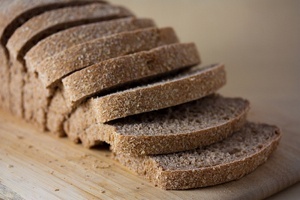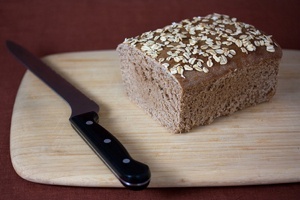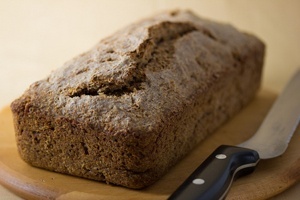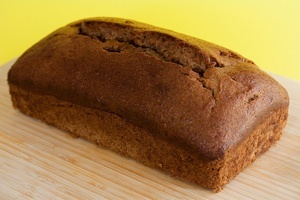
A tough of sugar takes the edge off the bitterness of the rye in this Easy Vegan Rye Bread recipe. Molasses has been added to increase the overall richness of the rye flavor and caraway seeds adds an interesting layer subtle spicy cool to the loaf. Feel free to experiment with these additions and change them if you prefer. The loaf will still turn out roughly the same.
Initially I was intrigued by the flavor of rye breads but intimidated by baking them. How was I supposed to bake flavorful, crusty loafs with most of the leavening-enhancing gluten out of the picture? A little research found that although rye flour contains about the same amount of protein than regular flour, most of this protein isn't from
glutenin and
gliadin, the two protein compounds that unravel and combine to create gluten when water is added and the mixture is kneaded. What rye flour does contain though are natural gums called
pentosans which absorb about 16 times their weight in water. This is the puzzle piece of how these breads are crafted.
The role of pentosans in rye breads
Rye berries do contain small amounts of glutenin and gliadin but just not enough to make a considerable effect in baked goods. Pentosans hydrate and swell which is a contrast to gluten which forms long sticky strands that enforce bread like rebar in concrete. These vegetable gums can become overworked extremely quickly, resulting in an excessively gummy dough that won't hold air bubbles during leavening. The pentosans in rye flour don't aid leavening as effectively as gluten does in wheat flour so I've found an optimal ratio of high-protein bread flour to rye flour so a loaf with respectable rise will still result.
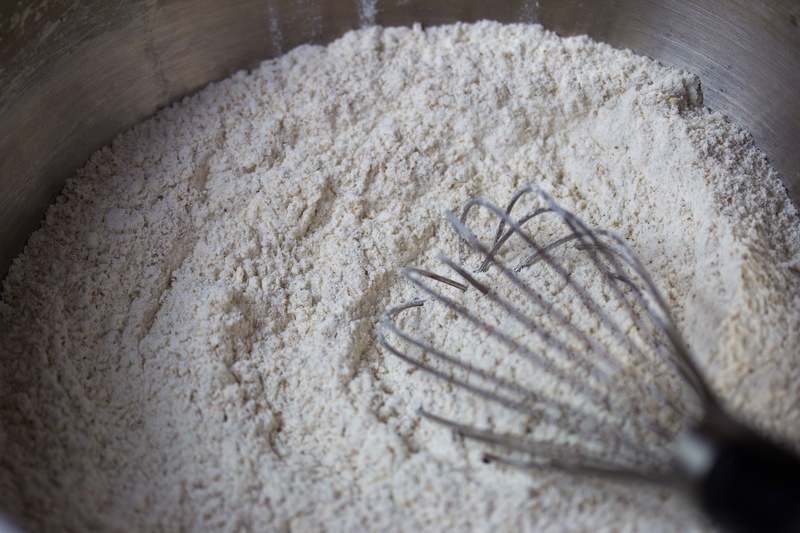
Dark rye flour isn't actually dark. This loaf is slightly golden in color due to the addition of molasses. If you'd like to make a white rye then the molasses can be omitted.
Find more
Rye recipes on Veganbaking.net
Easy Vegan Rye Bread Recipe
1 ¾ cups + 3 Tablespoons warm water
2 ¼ teaspoons, or one ¼ ounce package active dry yeast
2 ½ cups bread flour
1 ½ cups dark rye flour
1 ¾ teaspoons salt
1 Tablespoon sugar
1 Tablespoon molasses
2 teaspoons caraway seeds
1) Activate the yeast
In a small mixing bowl, whisk together the warm water and yeast. Allow the mixture to sit for about 10 minutes so the yeast activates.
2) Whisk together the dry ingredients
In a medium mixing bowl, whisk together the bread flour, dark rye flour and salt until well incorporated.
3) Whisk together the wet ingredients
In another medium mixing bowl, whisk together the sugar, molasses, caraway seeds and stir until just combined. Whisk in the warm water mixture from Step 1.
4) Mix the dough
Add the wet ingredients to the bowl containing the dry ingredients and stir with a wooden spoon in one circular direction for 1 minute. Now stir in the opposite direction for 1 minute.
5) Coat the ball of dough in vegetable oil
Add about 1 Tablespoon olive oil to another medium mixing bowl and spread it around the inside with your fingers. Use a spatula to scrape the dough into the oily bowl. With dampened fingers, form the dough into a ball and rotate it around in the inside of the bowl so it's coated in oil.
6) Let the dough rise
Cover the bowl with a plastic bag and let it rise in a warm place until it's doubled in size, about 1 ½ hours. Alternatively, place in the refrigerator for about 12 to 24 hours. Remember that we want our dough to double in size regardless of whether it spends a full 24 hours in the refrigerator or rises at room temperature. Feel free to let it rise in the refrigerator for some of the time and outside of the refrigerator the rest of the time.
7) Let the dough rise once more
Degass the dough by pressing on it with dampened hands several times until no more gas comes out of the dough. Form the dough into a ball again and let it rise until it's doubled in size, about 1 ½ hours. If you did your last rise in the refrigerator, do this rise at room temperature and allow 4 hours of rise time.
8) Proof the dough
The dough can now be
proofed by gently forming it into a lightly oiled loaf pan and allowed to sit covered with a plastic bag until it reaches about 80% to 90% of it's intended size, which should be about 40 minutes. The proofing stage is where the dough takes most of it's shape. It's important to leave room under the plastic bag so the dough can rise sufficiently.
9) Bake to perfection
Preheat your oven to 375F (191C). Remove the plastic bag so the dough can rest for about 10 minutes while your oven is preheating. During the baking process, the dough will rise another 10% to 20% of it's intended size in the process known as
oven spring. Bake until the internal temperature of the bread measured with an
instant-read thermometer registers 180-190F (82-88C). Rotate the loaf 180 degrees in the oven halfway through the baking duration for even baking. If you don't have a thermometer, this is about 40 to 45 minutes or until the bottom of the loaf sounds hollow when the loaf pan is tapped with a blunt object like a rolling pin.
10) Cool the vegan rye bread completely
Since this rye bread isn't bound together with gluten we need to wait until it cools completely before removing it from the loaf pan. This bread is best stored covered in a cool dark place or pre-sliced and stored in a plastic freezer bag in the freezer. This recipe makes one loaf of Easy Vegan Rye Bread.





